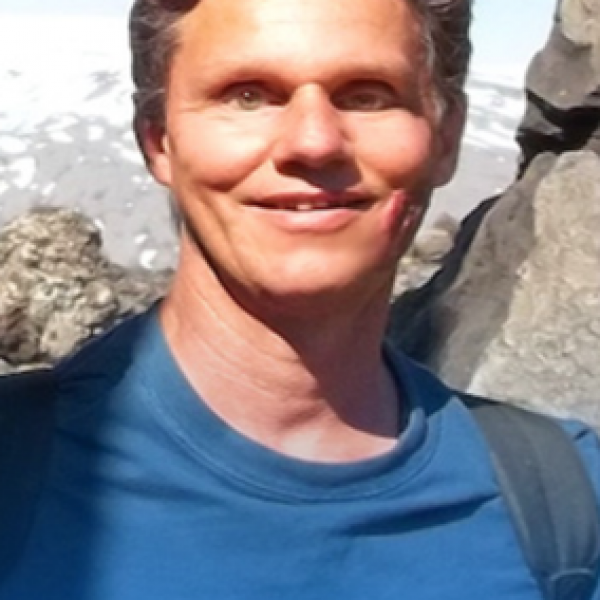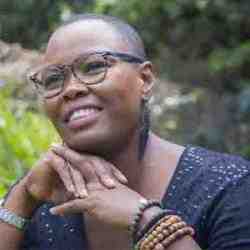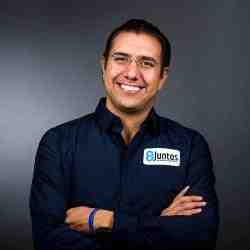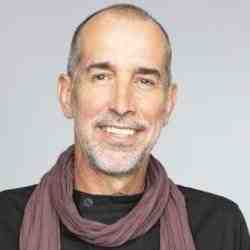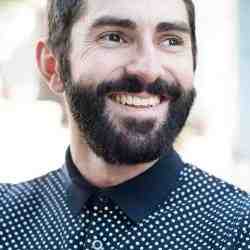Introduction
Daniel Kish is transforming the blindness profession and the lives of people around the world through a model of perceptual navigation that is more respectful of blind dignity and purpose, easier to teach, learn, and use, and is more diversely applicable to all ages, cultures, backgrounds, and ability profiles.
The New Idea
Daniel believes that we must ensure freedom, independence, and mobility for blind people, especially for blind children. Parents of blind children usually lack firsthand experience with blindness, and there is a well-documented resource gap for young kids (as they have historically been deemed “too young” for the trainings and services on offer). Daniel believes that fear is the greatest enemy of independence, and that a lack of independence breeds more fear and greater hopelessness. Unfortunately, the global blindness profession has historically been very slow (and resistant) to change. Today young blind people are increasingly less mobile; blind adults experience 60%+ unemployment and society expects little more of them.
Informed by his own personal and professional experience, Daniel has created a new model of Perceptual Navigation training which may be the most disruptive innovation since the guide dog. Daniel lost his eyes to cancer at 13 months but was raised by parents who prized his independence and ensured he had a childhood full of freedom and free of fear. As a very young person with total vision loss he was still able to bike to school, climb trees, and play tag with his friends who were all sighted. This is because early on Daniel realized (and has since scientifically proven) that by producing a clicking sound with his tongue and using its echoes to “echolocate”, he was effectively able to replace “sight” by allowing audible spatial feedback to light up the visual cortex of the brain. Since then, he has become the first totally blind person to be certified in the traditional Orientation and Mobility profession, and he has developed a practice and training that he and his team of blind instructors has since delivered through activations around the globe to thousands of people in more than 40 countries. According to Daniel, “the individual transformation, we have found, is quite easy; it’s not that hard. But in order to affect individual transformation, you have to affect the system in which the individual is an element.”
To affect – or change – the system, Daniel continues to bring changes to the blindness profession, from leveraging the Americans with Disabilities Act to pave the way for more blind mobility instructors like himself to creating a wholly new practice and certification model built on his innovations around FlashSonar, natural cane use, and his “No Limits” philosophy. Daniel has gained widespread media coverage that he believes helps change the conversation and he is also overhauling academic preparation through the textbook he authored and by influencing university accreditation programs.
Through all these efforts he is challenging the profession’s lack of understanding and appreciation for the power of the non-visual perception system, and break it out of its emphasis on “custodialism” over promoting self-efficacy. At the end of the day and through all these efforts, Daniel is shifting wider cultural perceptions and the limiting beliefs of those in the blindness community, profession, and beyond.
The Problem
The fundamental problem Daniel is working to solve is a lack of mobility among blind people. The unemployment of two-thirds of the adult blind community can be linked directly to the current inability of many blind people to navigate their environment freely without assistance. Blind youth are graduating high school without the independent navigational skills necessary to attend college or find work. Parents of blind children do not know how to navigate an opaque system of resources and training tools. And there are few resources available for young children, who are often not believed to be capable of learning Perceptual Navigation skills like cane usage. Children without access to mobility skills are often fearful and struggle to keep up with their peers and pursue developmentally-appropriate activities. Unfortunately, risk-averse teachers and parents who limit children's activity produce children who will not take the risks needed to develop new skills.
Blind people, however, are not innately immobile. The one-third of blind people who are currently employed are found in careers in nearly every field. The capacity is there. Current approaches to Perceptual Navigation that foster dependency and restriction rather than independence and freedom are the problem. Children who are encouraged to get around by holding someone's hand or holding onto a wall will not learn to navigate independently unless those things are taken away. They will develop what Daniel calls "dependency conditioning,” a type of learned helplessness. Their self-perception will not include a sense of competency or the capacity for independence. The public belief that blind people cannot be independent thus becomes a self-fulfilling prophecy, resulting in blind people who are not independent.
Similar problems affect the lives of people with all disabilities, not just blindness, and – to some degree – all people who let their fears hold them back. When it is believed that people with disabilities are not capable they are not taught the skills and given the opportunities to prove that they are. But blindness – in and of itself – does not drive nor fully explain developmental delays or immobility. Daniel believes that the desire for freedom and independence drives all development, and blind people are merely more consistently denied their freedom by those around them and – eventually – themselves. A sea change in the way blind people are perceived, taught, and allowed to navigate the world, will contribute to broader change for people with all disabilities.
Daniel’s work, then, must speak directly to blind people and their families as well as to public at large. But Daniel understands that we must also directly challenge a key intermediary between blind people and their full participation in society: the blindness profession. The first wave of blind mobility trainings – conceived of by parapathologists at the Veterans Administration after WWII as rules-based, regimented, protocols inspired by blindfolded sighted people – are, according to Daniel, “not a bad place to start, but a dreadful place to finish.” This approach is still the most mainstream, though in the 1970s, as more blind people entered the workforce and, eventually, the upper ranks of the national Rehab Services Administration, an alternative model that was more natural and fluid was introduced. But where it was stronger because of its rootedness in individual agency and autonomy, it lacked some of the scientific rigor of the VA’s first attempt. For example, cane training for anyone who desired it was a prominent component, but the recommendation of the pointer grasp, the body-width sized arching motion, and the two-point touch where the next steps land was not evidence-based, emphasized form over function, and predicted a sort of stilted marching, not to mention tension in the wrist, arm, shoulder, and body. According to Daniel, “the old vanguard contrived by convention and handed down by tradition is insufficient to help blind people reach current standards in a modern age. Having met with limited success at proving itself of definitive value, the blindness profession now labors under political and economic disillusionment.” Unfortunately, Daniel believes that “despite much lip service to ‘independence’ over the passed 60 years, most blind people remain without the skills and resources to emerge from isolation, poverty, and restriction.”
The Strategy
In a world with a sighted majority and where the primary medium for commerce, social contact, and staying connected is visual symbols (be they written words, pictures, arrows, lines, or icons), the general public can barely comprehend the unique strengths and challenges of blind people, much less how to leverage these strengths and address challenges effectively and respectfully. Daniel recognizes that society and the human perceptual system are centered around seeing. At the most basic level he’s simply proposing that the process of “seeing” need not be confined solely to the eyes as “seeing constitutes a broader, more dynamic and diverse process of perception drawn from an integration of physiological, psychological, social, and spiritual (psycho-energetic) processes.”
At first intuitively and as a young blind boy, and then with a laser focus during his early adult years, Daniel has proven that specific, relatively simple interventions can leverage the brain’s plasticity so that audible spatial feedback can light up the visual cortex. Whether it’s embracing the echolocation technique (that comes naturally to many young blind children but is usually suppressed and almost never enhanced) or adopting a more natural model of cane training, Daniel has proven that people with even total vision loss can create a functional image of the surrounding environment consisting of a composite of all sensation, ideas, and experiences -- a new way to see. Daniel describes his clicking as a way of communicating with the environment. To him, the clicks are questions of “what are you” and “where are you?” Just like light, the sound bouncing back then lights up the environment, implicating the brain’s visual system in the process. Over time one learns to ask better, more direct questions. Daniel calls this approach "Perceptual-Navigation”, defined as "engaging the whole brain in a developmentally natural manner that activates the perceptual imaging system by fostering self directed freedom of discovery." Scientific, academic, and medical studies as well as personal testimonies attest to its effectiveness, and Daniel’s techniques including training in use of “FlashSonar” and his “No Limits” teaching philosophy have been refined through thousands of examples around the world, resulting in a global community of people who’ve transformed their lives through a new paradigm of self-directed discovery and freedom first. Daniel, his team of trainers, and leagues of blind people around the world can confidently go anywhere, including places they've never been and where they don't speak the language.
Demand for Daniel’s direct services are high and his time is in short supply. Which a solid global demonstration of what works, Daniel has now positioned his approach, though radical, as a viable and dramatically different model capable of getting the blindness profession unstuck. As Daniel has predicted, the blindness profession has been resistant to change, but it is shifting. While the foundational textbook in the field of Orientation and Mobility – which outlines the certification process, designs the exams, and issues accreditations – still has no blind authors, it does now include a more expanded section on echolocation. And Daniel’s own textbook outlining his own process and its developmental and scientific underpinnings is well recognized in the field, and coming to be used across all the university prep programs for “O&M” in the US. Furthermore, he and his collaborators are in the process of developing their own certification system for various levels of trainers.
Today WAFTB has a core group of master teachers in the US and Europe who provide direct services and also train additional trainers. They formally partner with five stand-alone training organizations on 4 continents and – perhaps most importantly to Daniel – organizations around the world (like Blind Beginnings in Canada and World Access for the Blind, Australia) have adopted his “No Limits” philosophy as a central and guiding value. And across the world, spurred by Daniel's work and grassroots parental advocacy, there has been the extension of traditional mobility training (using canes, for example) to younger children who were previously believed not capable of learning to navigate or of using canes safely and effectively.
Daniel’s story has now reached tens of millions of people, which he sees as a critical investment in “fertilizing the soil to be receptive to a wave of change” by reaching individuals, parents, schools, members of the blindness profession, and the public at large. He’s come a long ways since his media debut on a late-night show about the supernatural called “The Other Side”, which was naturally followed by an appearance on a paranormal program called “Sightings” and “Ripley’s Believe It or Not” where he earned the nickname the “Real-Life Bat Man.” These days you are more likely to learn about his work in magazines like National Geographic and Readers Digest, newspapers like the Los Angeles Times, radio programs like This American Life, TV news segments like Inside Edition, or as one of the more than one million viewers of his well regarded TED talk. An online search of local press coverage from around the world provides hundreds of personal anecdotes and videos of Daniel and his trainers leading bike rides, hikes along steep cliffs, or strolls through busy city streets.
These days, Daniel and his team are working on a way to circumvent the issues of supply and demand that prevent them from working with the number of people who could benefit from their program. Over the next 18 months, Daniel is launching a multimedia online platform (with tiers for online coaching or in-person support, if desired), which directly challenges the core barriers and at a wildly lower price point (starting at ~$100 compared to 30-60k per guide dog, for example). Not only will the materials demystify disability and blindness, but they will teach the basics of FlashSonar-based Perceptual Navigation through video and printed materials and explain the systems available and how to navigate them. People who want further instruction than the modules can provide will be able to work with an online coach, and people who need more than that will be able to work directly with a current trainer (with more moving through the certification process).
Aside from the technical skills Daniel has to share, his core message is that blind people are not limited so much by their loss of sight as they are by societal ideas about what blind people are capable of. Limited expectations for them diminish their opportunities to learn things they are not perceived as capable of learning. Daniel’s new model of independence and competence rising to the fore in the blindness field has implications for the way we as a society view disability in particular, and human achievement in general. Given the robust body of scientific evidence that the brain becomes more alive and new neural pathways form within minutes of activating under-utilized senses, Daniel believes everyone can benefit from some type of “sensory awareness training”. By putting on a blindfold, a sighted person doesn’t just compensate with other senses; as he does so the chemistry and blood flow of his brain actually changes and he beings to think differently, or to think new thoughts entirely. The organizing, planning, and executive functioning units of the brain all have the opportunity to grow. He doesn’t just hear better, he listens better. And he’s less fearful. In fact, Daniel often points out that many humans’ deepest fears are of the dark or of the unknown. Therefore, if you’ve successfully adapted to blindness, you’ve overcome some of humans’ greatest challenges. Daniel believes this way of thinking can help achieve true empathy with the blind community and empowerment for all. It’s not enough for sighted people to experience “being blind.” It’s in adapting to blindness, in embracing a “no limits” freedom-first mentality, and overcoming fear where the real potential for learning and transformation – at a personal and societal level – lies.
The Person
Daniel Kish lost both of his eyes to retinal cancer when he was a year old. The first thing he did after his second surgery was climb out of his crib and begin exploring the intensive care nursery. He has not stopped exploring since. Like many blind children, he developed the system of tongue clicks that later became FlashSonar, and this allowed him to discern the world around him. Unlike many other adults, his parents didn’t discourage the tongue clicking. On the contrary, they encouraged his sense of exploration and did not allow fear of the unknown to be a part of his life or their approach to his blindness. He refers to this approach as "befriending the unknown." He walked himself to school, rode a bicycle independently, climbed trees and played games of roughhouse and tag with other children. His upbringing, which was very typical for a child but atypical for a blind child, informed his “No Limits” philosophy to later teaching Perceptual Navigation.
Daniel went on to earn Masters degrees in Developmental Psychology and Special Education. During this time he conducted pilot research to develop the first documented methodologies to teach FlashSonar echolocation to other blind people. He became the first totally blind person to earn certification to teach blind people how to navigate. His entry into the field was met with controversy and skepticism, but it has set a precedent allowing more blind people to become certified and enter the field. During this time, his new method of navigation and innovative approach to Perceptual Navigation was attracting attention in the media and in the blindness community, and he eventually determined that he needed to start his own organization, World Access For The Blind, to teach his methods to other blind people and to train other teachers so that his model could spread.
He does not know of one moment that inspired him to begin the work, but he tells a powerful story of what inspired him to continue. He was working in Mexico with a blind child named Daniel, who had lost his sight at age six. Young Daniel was embittered by the ridicule of his peers and bewildered by his new limitations, but eagerly learned FlashSonar and returned happily to his peer group, regaining their respect with his restored ability to navigate and participate in competitive play. One day, Daniel Kish was playing soccer with young Daniel and his friends, navigating by FlashSonar and aided by a plastic bag tied around the ball so that it crinkled when it moved. Young Daniel was a competitive force on the soccer field. When the bag broke, he was able to play about 75% as well as before, but lost much of his competitive edge. Another young boy, Kevin, bicycled quickly home and breathlessly returned with a new plastic bag so the game could continue as before and young Daniel could regain his edge. His interaction with Daniel came at a time when the future prospects for World Access for the Blind couldn’t have been more bleak; Daniel’s utilities had been shut off and he was surviving on very little income. But this moment steeled his resolve and has stuck with him as a powerful example of not only what his work can do, but both the skill and the kindness people are capable of with the right kind of support.
